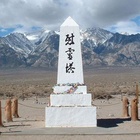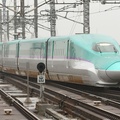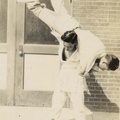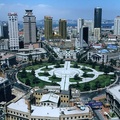マンザナーでの実習は、3日目を迎えました。私はキャリーさんと一緒に、東カリフォルニア博物館(Eastern California Museum)を訪れました。
東カリフォルニア博物館は、マンザナーをふくめた、インヨー郡(Inyo County)の歴史に焦点をあてた博物館です。マンザナーからは、車で約15分ほど北上したところにあって、インディペンデンスの街の中心にあります。今回、マンザナー以外に、東カリフォルニア博物館に足を運んだのは、私のマンザナーでの実習における、プロジェクトを決めるためです。
博物館へ到着すると、私は博物館の責任者でもある、ベス・ポーターさんに会いました。そして、30分ほどかけて、博物館のなかの展示に目を通しました。
東カリフォルニア博物館の展示は、大きく3つに分けることができます。初めに、ネイティヴ・アメリカン。次に、インヨー郡に入植した、白人の開拓者。そして、マンザナーと日系人です。3つの展示を通して、私はカリフォルニア州の歴史の一幕を学び、さらには、インヨー郡の歴史をたどることで、日系人の収容施設が、マンザナーのような場所に建設された理由を学びました。
インヨー郡のあゆみ
インヨー郡には、数世紀にわたって、パイウート(Piute)とよばれる、ネイティブ・アメリカンの人々が、生活を営んでいました。しかし、19世紀を迎えて、ゴールド・ラッシュの時代に突入すると、多くの白人が入植し、開拓者の町として発展するようになりました。
現在のインヨー郡の姿からは、想像しがたいものではありますが、この地域は、水に恵まれていて、農耕や牧畜に適していたのです。マンザナーのオート・ツアーの経路には、シェファード牧場跡、チャフィー果樹園跡、ワイルダー農場跡がありますが、それらは、インヨー郡の開拓者たちによって、営まれたものでした。
ところが、20世紀を迎えると、水資源に恵まれていたインヨー郡は、その姿を大きく変えていきました。急激な人口増加への対策が迫られていたロサンゼルス市が、水の供給のために、インヨー郡の土地に目をつけたのです。当時のロサンゼルス市長であった、フレッド・イートン(Fred Eaton)は、水利権を得るために、インヨー郡の土地買収計画をたてました。これには、インヨー郡からロサンゼルスまでの約350キロメートルにおよぶ、「ロサンゼルス水路(Los Angeles Aqueduct)」を建設することも盛りこまれていました。
当然のことですが、インヨー郡の住人たちは、ロサンゼルス市の“横暴”に激しく抵抗しました。しかし、土地の買収がはじまると、多くの住人は為す術も無く、インヨー郡を去っていきました。これら一連の歴史的な出来事は、「ロサンゼルス“水”戦争(Los Angeles Water War)」として、知られています。
そして、日米戦争が勃発したころには、インヨー郡の水資源は枯渇同然とされ、周辺地域への環境破壊が懸念されるようになっていきました。そのような経緯から、アメリカの政府は、日系人を収容する施設の建設のために、この地を選んだのです。マンザナーが建設されたのは、1942年の春のことでした。
© 2011 Takamichi Go






